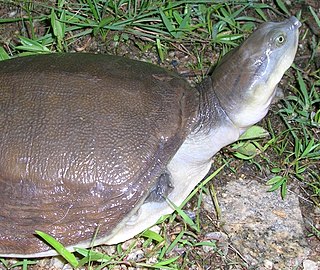
The eagle rays are a group of cartilaginous fishes in the family Myliobatidae, consisting mostly of large species living in the open ocean rather than on the sea bottom.

Carcharhinus is the type genus of the family Carcharhinidae, the requiem sharks. One of 12 genera in its family, it contains over half of the species therein. It contains 35 extant and eight extinct species to date, with likely more species yet to be described.

The bat ray is an eagle ray found in muddy or sandy sloughs, estuaries and bays, kelp beds and rocky-bottomed shoreline in the eastern Pacific Ocean, between the Oregon coast and the Gulf of California. It is also found in the area around the Galápagos Islands. The largest specimens can grow to a wingspan of 1.8 m and a mass of 91 kg (201 lb). They more typically range from 9.07–13.61 kg (20.0–30.0 lb). The size of the bat ray is dependent on many factors, such as habitat alterations, different oceanographic and environmental conditions. Bat rays have one to three venomous barbed spines at the base of its tail. Some bat rays are solitary while others form schools numbering in the thousands.

Lissemys is a genus of softshell turtles in the subfamily Cyclanorbinae of the family Trionychidae. The genus is indigenous to southern Asia.

Myliobatis is a genus of eagle rays in the family Myliobatidae.

Cycloderma is a genus of softshell turtles in the subfamily Cyclanorbinae of the family Trionychidae. The genus is endemic to Africa.
The Hannold Hill Formation is an Early Eocene (Wasatchian) geologic unit in the western United States. It preserves the fossilized remains of the ray Myliobatis and gar.
The Piney Point Formation is a geologic formation in Virginia. It preserves fossils dating back to the Lutetian Stage of the Eocene Epoch of the Paleogene period.
The Bashi Formation is a geologic formation in Alabama and Mississippi. It is named for Bashi Creek in northern Clarke County, Alabama, which cuts through some of its exposures. It preserves fossils dating back to the Eocene period, or Wasatchian in the NALMA classification.
The Temblor Formation is a geologic formation in California. It preserves fossils dating back from the Late Oligocene to the Middle Miocene of the Neogene period. It is notable for the famous Sharktooth Hill deposit.
The Curré Formation is a geologic formation of the Taraba Basin Group in Costa Rica. The deltaic conglomerates preserve fossils dating back to the Late Miocene to Early Pliocene period (Hemphillian).
The Chagres Formation (Tc) is a geologic formation in the Colón Province of central Panama. The sandstones and siltstones were deposited in a shallow marine environment and preserve fossils dating back to the Middle to Late Miocene period.
The Lagunitas Formation is a geologic formation in Cuba. The open marine, fluvio-deltaic and lagoonal claystones, limestones and conglomerates preserve fossils dating back to the Early Miocene period. Among others, the fossil primate Paralouatta marianae, the largest primate of the Miocene New World, was found in the formation. Based on microfossils, the age has been determined as Burdigalian.

The Leitha Limestone is a geologic formation in Austria, Czech Republic, Hungary and Poland. It preserves fossils dated to the Middle to Late Miocene period.
The Weissenegg Formation is a geologic formation in Austria. It preserves fossils dating back to the Miocene period.
The Langental Formation, also spelled as Langetal Formation, is a Late Eocene geologic formation cropping out in the Sperrgebiet, ǁKaras Region of southwestern Namibia. The siltstones and sandstones of the formation were deposited in a shallow marine environment. The Langental Formation was deposited under hot and humid conditions. The formation overlies the Silica Beds unit and is overlain by the Blaubok Conglomerate. The Langental Formation provides many fossil invertebrates and fish.
The Maria Farinha Formation is a geological formation of the Parnaíba Basin in Pernambuco, northeastern Brazil whose strata date back to the Danian stage of the Paleocene, or Tiupampan in the SALMA classification.





